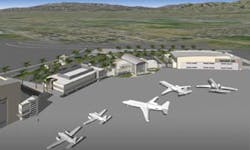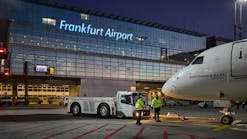SAN BERNARDINO, CA — Riding around on a tour of the former Norton Air Force Base airfield, aviation director Bill Ingraham, A.A.E., points to the heavy iron mod/paint/maintenance facilities; the fixed base operation and its Quonset hut environment; and the new 150,000-gallon fuel farm. Off in the distance, a biplane is doing touch and gos. Then comes the tour highlight: a $38 million corporate/commercial terminal and hangar complex that will open in late 2008 and be operated by Million Air Interlink under a management contract. When completed, the development brings to San Bernardino International Airport the ability to market to corporates, while also pursuing its first commercial airline service.
Explains Million Air Interlink president Roger Woolsey, “San Bernardino came about when the airport authority and the Inland Valley Development Agency [IVDA] were looking to develop that area of Southern California. Ontario [International] falls under LA fees, which are very high. San Bernardino offers the opportunity to develop the general aviation side of it. All in all, we’ve gotten a lot of interest in using that facility. There’s a shortage of corporate hangar space in the region.
“We are going to build a world-class facility. We’re going after the large aircraft market. There are several corporate 747s that don’t quite fit at our LA region FBOs. They need a home.
“Servicing the commercial side is also our goal. We’re still in negotiations on that.”
Since the closure of Norton in 1994, the San Bernardino International Airport Authority (SBIAA) and the IVDA have operated in concert to develop the former Air Force properties. The airfield is operated and being developed by SBIAA; property outside the fence of the airport is the responsibility of the IVDA to develop. The aim all along has been to create jobs — when Norton closed, 10,000 jobs went as well.
In 2002, IVDA teamed up with Hillwood/San Bernardino LLC., in a joint development agreement. Based inTexas, Hillwood is a Ross Perot company and the master developer of the Alliance Airport and neighboring properties north of Ft. Worth. The success in commercial development off-airport has led to development of the airport — IVDA is SBIAA’s top source of funding.
Explains Ingraham, “The IVDA creates an initial source of revenue when its property is sold and developed; and then it creates a tax increment, a portion of which comes back to the agency. That can come over here in the form of a grant or a loan.
“SBIAA has the ability to borrow or take grants from entities, including IVDA. Now, IVDA should ultimately get paid back, when things can pay for themselves.
“It’s a very advantageous position for the airport authority here to have a source for funding to make things like this happen.”
New terminal complex
Central to the business aviation and commercial airline developments is the terminal/hangar complex, which Ingraham says totals an investment of some $38 million by the airport and the private sector. Airfield infrastructure is in place, with a rehabilitated 10,000-foot runway and a new control tower which Ingraham is working to get into the Contract Tower Program.
Scot Spencer of SBD Aircraft Services is the key private investor. His company is the master lessor of the large aircraft maintenance complex, which houses various subtenants, and is the primary tenant at San Bernardino today. He is also the investor behind the FBO/terminal complex, which will be able to accommodate up to ten airline gates.
When opened, the facility will be operated and staffed by Houston-based Million Air Interlink via a management agreement similar to one the company has at Albany (NY) International Airport, where it operates the FBO for the airport.
Comments Woolsey of Million Air, “We’re also going to be doing the commercial service and completely managing the project, similar to the Albany project. We provide the staffing; they give us complete reins on how to run that company.”
The complex is part new, part rebuild of a former Air Force terminal, explains Ingraham. “What we did here is lease the building to a developer, similar to a design/build operation,” he says. “We had to use the old building in order to meet a time schedule. We wanted to have all this done this year — 18 months ago this was an idea.
“As tough as the California environmental process is, you could not have done it if you weren’t remodeling a building. So, that’s the biggest part of the project.”
To accommodate corporates, the airport authority recently approved an initial proposal to build a $9 million hangar for corporate jets. The hangar rests on a nine-acre parcel, which reportedly will be built by private dollars, purchased back by the airport, and then leased. The airport plans to invest some $3.5 million for associated infrastructure.
To attract commercial airline service, the airport authority has a marketing department. Despite today’s harsh airline service development climate, Ingraham says he’s optimistic of attracting San Bernardino’s first commercial service.
“It’s going well,” he says. “We have people who are more than interested, and we’re talking of potentially having air service by the end of the year. Right now, if the parties that we’re talking with come through, we’re not on the street soliciting additional air service. We’re going to try to make that work.
“Everything says that there is a market here. It’s more leakage than competition [with other apts]. There’s sufficient unspent demand in this basin, according to our studies and others, even LAWA [Los Angeles World Airports] studies. We believe it’s here; we have a population of a million or so within a small radius. It’s more of a matter of when, not if.
Initially, Ingraham envisions five departures a day, but prefers not to discuss the destinations. The airport purchased used baggage handling systems and eleven boarding bridges, which are undergoing refurbishment. The Transportation Security Administration is also on board with the progress of the airport’s air service efforts.
Comments Ingraham, They’re involved; they look at this probably every couple of weeks. We’re working through all the regulatory and logistics issues. They have an individual who has been assigned to kind of watchdog us.”
In June the airport issued a request for proposals for a concessionaire for the passenger terminal. “There is interest,” says Ingraham. “We have a couple of companies that have expressed what it takes to make this work. Not having an airport with established air service, it’s very difficult to negotiate terms. We don’t want somebody to fail; and we don’t want to mislead them. I have one large company that worked with some concepts on how they would lay it out, which gives us a starting point.
“I feel very solid with where we are today. There are two potential airlines that are candidates. But I recognize the environment we’re working in; if it doesn’t work, we’ll be ready for the next opportunity.”




